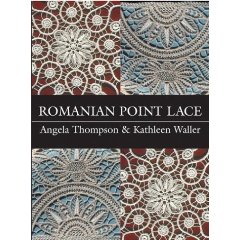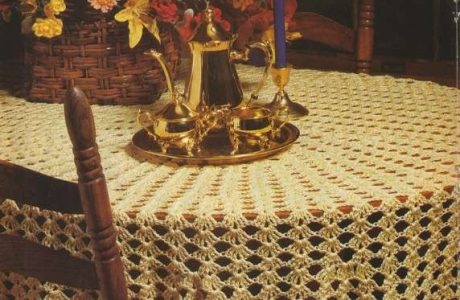Little did I know when I found this lovely book at the library that one could not buy one for less than $185!!
The list price inside the cover is $26.95. It was published in 2003 by BTBatsford Publishing (UK) and distributed by Sterling Publishing in the US. Authors Angela Thompson and Kathleen Waller are certainly passionate and well informed on their subject. This book is a joy to read. It’s an impressive book, thoroughly researched and clearly written.
From this book, I learned that Romanian Point Lace (its common name) (RPL)is found in Belgium, Czech Republic, Germany, Hungary, the former Yugoslavian countries, Egypt, and Israel. In England, it’s typically called Hungarian Point Lace. Around the world, it may have different names, but they all describe this unique braid lace with delicate filler stitches called needlepoint lace. This specific artform was developed sometime in the 1930’s when flat braid or tape lace was joined with the delicate needlepoint lace stitches.
It actually appears to have originated in Transylvania (yep, Count Dracula territory) which was once a part of Hungary and later part of Romania. Romanian nuns took the technique with them to Egypt and taught it to daughters of European expatriate families there.
RPL is a firm tape or braid lace – a group of laces that use an outline braid or tape securing filler stitches of delicate needlepoint lace. Battenberg Lace may be a more familiar tape lace. The filler stitches are often referred to as ‘bobbin lace stitches’ although it is not ‘real’ bobbin lace. The braid or lace is created with a crochet hook and crochet stitches.
A foundation braid begins all projects. The specific way each braid is crocheted creates a tiny picot loop into which the filler stitches are anchored. The work is supported by a backing fabric on which the design to be worked has been traced. The braid is basted to the fabric so that the intricate filler stitches can more easily be worked. Once finished, the backing fabric is removed and can be reused.
This book goes into great detail with excellent pictures and schematics to show how to create the braids and filler stitches. Many variations of braid are presented. Further, applications for using each shape of filler are shown in color photos identifying each unique stitch used.
More recently, these techniques have been popularized in the US by Romanian born Silvia Murariu in privately published books and Ioana Bodrojan in Piecework Magazine. The earliest US publication about RPL appears in Coats Booklet #525 Doilies in Coats Mercer Crochet in the late 1960’s. Also, in the 1960’s, Anna Burda published in formation on the technique calling it Macrame Crochet.
Interesting trivia: a ring stick (like jewelers use to size finger rings) is used to create consistently sized crochet-covered or buttonhole-covered circles.
Grapes – a common motif – are made with buillion stitches.
Different braid shapes include very decorative designs containing cirles, ovals, S-shapes, and various flat braids. The flatter braids resemble macrame.
This book also contains a great section on getting started in RPL with simple patterns. The first pattern is a 3-petal flower on a stem with 2 simpy shaped leaves. Other simple patterns and their applications are presented – greeting cards, needle cases, fabric inserts, and bookmarks. The bookmark on page 82 is a favorite of mine. There are also pretty ‘Christmas Bells’ in various colors made by crocheting simple tulip shapes and turning them upside down. Very effective. Other flat designs are used to create or embellish place mats, coaster, and to decorate Christmas Ball ornaments.
More advanced designs and pattern adaptations are explored. Detailed instructions for planning the design along with fine, extreme close up photos of tiny filler stitches are included.
Finally, a thorough index listing specific books for further study and a good list of supply sources in the US, UK, and Australia is included. Here’s one of those sources:
http://www.sylviaslace.com/index.html
Book Specs:
ISBN 0713488328
144 Pages







c’est magnifique très raffiné merci
i saw the book on romanian point lace by angela thompason and katleen waller and i wish to obatain it. do you have any information from were i can buy one . thanks
scrivo dall’italia
avrei piacere di ricevere il libro:
ROMANIAN POINT LAC
se possibile, aspetto risposta
cordiali saluti bruna
I make and sell my items of tatting-baby booties, ear rings, necklaces, in frames, on hankies and more. Contact Donna-tattinglady@cfl.rr.com
I would like to make a correction to the history. Romania came from the former Dacia that was there before Atila the Hun invaded Europe. That means part of was ocuppied by Attila the Hun that came to form Hungary later on as a country. Transilvania was ocupied by Austro-Hungarian imperium and given to the Huns for management. Romanian point lace started arounf the 14th century, as a way to connect the narrow wowen textiles by the romanian peasants. The RPL does not have any connection to the Austo-hungarian occupation as someone may conclude reading the introduction.
Nana,
Thank you for your input here. History is not my strong suit. Your explanation is helpful.
jd
tengo mucho interes en comprar el libro, pero no se como hacerlo, porque quiero aprender a hacer trabajos tan bonitos.
I want to dearly thank Nana for putting right the history. Many times the world would take the history to be started maybe only about 50 years ago and this is painful.
As for the book is brilliant, just if would be more affordable and widely spread will be great.
Thanks for your effort too in presenting it.
When I initially commented I clicked the “Notify me when new comments are added” checkbox and now each time a comment is added I get four emails with the same comment.
Is there any way you can remove people from that service?
Many thanks!
hmmm. I think you can opt out (unsubscribe) from a link at the bottom of any email. if not, let me know privately (crochet at craftgossip dot com) and i’ll ask the tech admin about it.
jd